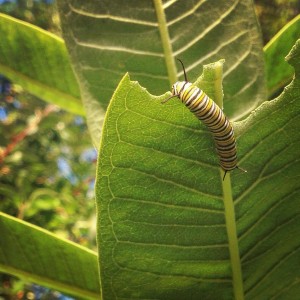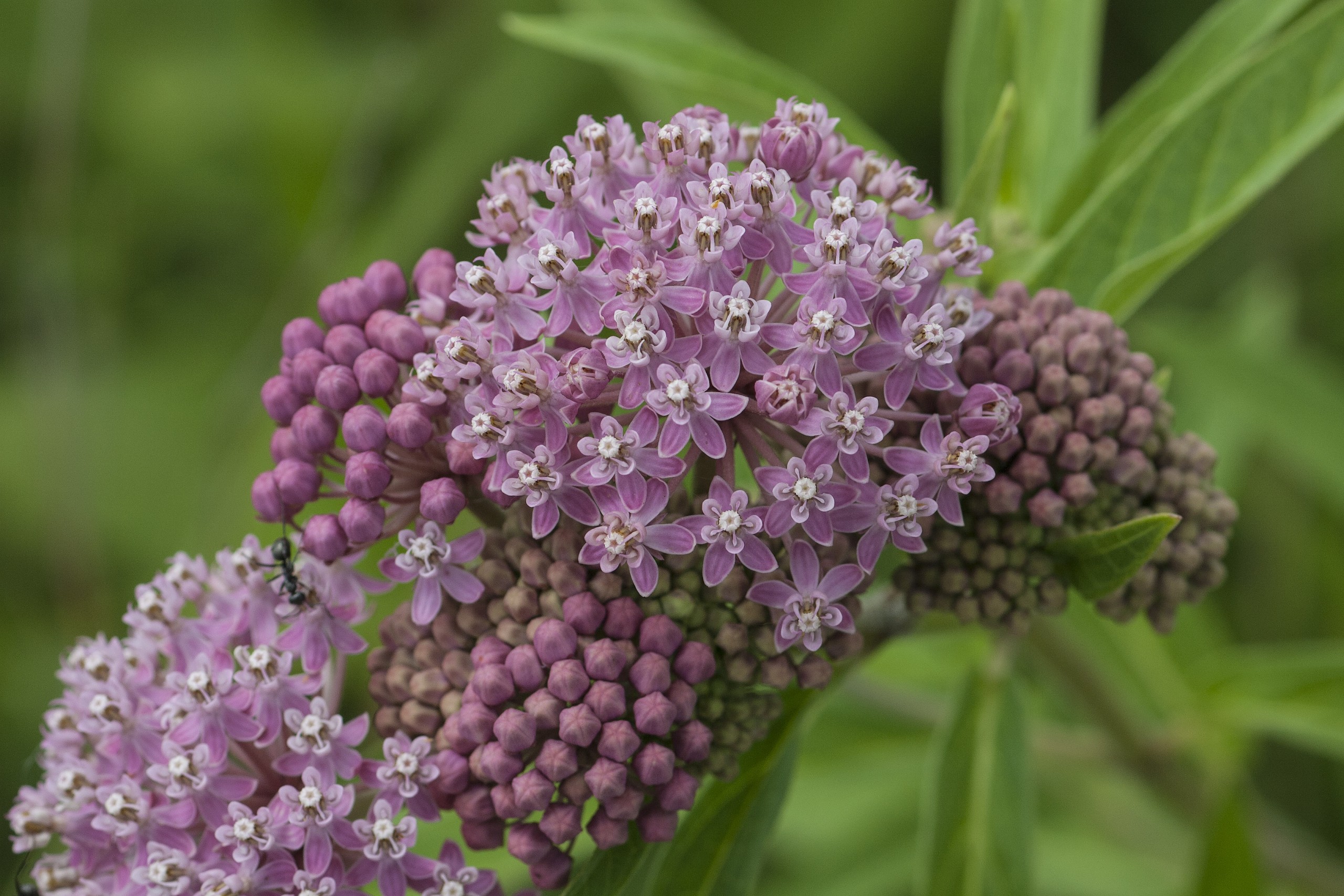by Steve Sass and Amanda Smith
By now, you’ve likely heard that one of our best-known and most beloved butterflies is struggling. According to the Center for Biological Diversity, the monarch butterfly (Danaus plexippus) population has declined by 90% since the 1990s. Most experts cite habitat loss, pesticide use, agricultural practices, deforestation, and climate change as the leading factors.

A monarch caterpillar eating the foliage of common milkweed (Asclepias syriaca)
The monarchs’ biology and life cycle make them increasingly vulnerable to changing environmental conditions and stressors. They are the only North American butterfly species whose life cycle consists of a two-way migration (like many birds do). Each fall, the “super generation” of Monarchs flies south, thousands of miles to their wintering ground in central Mexico. The following spring, they begin their return journey north, producing generations of shorter-lived offspring along the way. Factors such as the loss of suitable nectar plants (due to habitat destruction coupled with systemic pesticide use), vehicular collisions, mosquito abatement services, and conversion of their overwintering grounds to agriculture are all contributing to their decline.
Monarch’s dietary requirements also put them at risk. Although adult monarchs drink nectar from a variety of flowers, in their larval form (i.e., caterpillars), they are dietary specialists, incapable of eating anything other than the foliage of milkweed (Asclepias spp.). As we have converted most of our natural lands into agriculture and human developments, we have diminished the abundance of milkweed, which has profoundly impacted the available food sources for monarch caterpillars.
If we are to save this beloved butterfly for future generations, we must take corrective action. The United States Fish and Wildlife Service has proposed listing the monarch as “threatened” under the Endangered Species Act, which, if passed, would afford the butterfly federal protection. Organizations such as Monarch Watch, Pollinator Partnership, and Xerces Society have worked diligently to increase public awareness. Even ordinary homeowners, businesses, churches, government facilities, and other organizations can play a role in monarch conservation.

The Monarch Waystation at the New Carlisle Olive Township Library
The New Carlisle Olive Township Library is one such entity that has taken steps towards monarch conservation. In addition to the entirety of the native landscape, including the three-quarter-acre meadow, we have recently completed the installation of a certified Monarch Waystation situated along Bray Street where the sidewalk meets the entrance to the Exploration Garden.
Overseen by Monarch Watch, a not-for-profit conservation organization based out of the University of Kansas, Monarch Waystations help monarch butterflies by providing habitat, larval food, and adult nectar sources. For larval food, we have planted five species of milkweeds: common milkweed (Asclepias syriaca), butterfly milkweed (A. tuberosa), purple milkweed (A. purpurescens), swamp milkweed (A. incarnata), and whorled milkweed (A. verticillata). For nectar plants, the garden contains a variety of other regionally-native perennials with successional bloom times, including prairie smoke (Geum triflorum), prairie coreopsis (Coreopsis palmata), purple prairie clover (Dalea purpurea), smooth blue aster (Symphyotrichum laeve), and showy goldenrod (Solidago speciosa). Between the forbs, little bluestem grass (Schizachyrium scoparium) provides support, structure, and four-season interest.
Although milkweeds are inedible to most animals, monarch caterpillars and several other insects have evolved dietary defenses to circumvent the milkweed’s cardiac glycoside toxins and even benefit from them. Once the caterpillars ingest the milkweed’s sap, the toxins from the plant are transferred to the caterpillar, making them less appetizing to birds and other predators. Most of the insects that consume milkweed foliage display a bright orange or red coloration known as aposematism, which serves as a warning sign to would-be predators to leave them alone because they are toxic.
In addition to being critical to supporting wildlife, milkweeds are also extremely patriotic plants! During World War II, milkweeds played a notable role in the Allied War effort. Due to a supply interruption, kapok (a buoyant material used to fill life jackets) was in short supply. A nationwide campaign followed, encouraging school children to pick the floss from milkweed seedpods for use as a substitute. The campaign utilized slogans such as “Don’t let our sailors sink” and “Two bags save one life.” Unlike most typical box store and garden center offerings, our native milkweeds are truly as American as baseball and apple pie and not introductions from other continents. When in bloom (typically around the Fourth of July), their umbel-shaped inflorescences contain dozens of individual flowers, resembling a dazzling display of fireworks exploding into the sky.
The relationship between the monarch butterfly and various species of milkweeds reminds us that the beauty and splendor of nature are both complex and fragile. It’s up to us to ensure they will be around for future generations of Americans to marvel at as well.


